Op-Ed: Why banning assault rifles won’t reduce gun violence

An employee checks the chamber of an assault-style rifle at a shooting range in Randolph, N.J. on Dec. 9.
The gun control movement in America has been reinvigorated, and at the top of its agenda are bans on assault weapons. “The killers in San Bernardino used military-style assault weapons — weapons of war,” President Obama said Saturday, calling for a ban on these guns. Gun control proponents were also emboldened by the Supreme Court’s decision Monday to allow an Illinois ban on assault rifles to stand.
Yet we already know that banning assault weapons won’t reduce gun crime or deaths. Worse, the bans may make it harder to enact more effective gun control laws.
The only thing unique about assault rifles is their menacing name and look...
The problem starts with the term itself. The “assault weapons” for sale in the U.S. now aren’t really weapons of war. Many people mistake these firearms for machine guns capable of shooting multiple rounds of ammunition with a single pull of the trigger. The federal government banned the sale of machine guns to civilians in 1986. (The National Rifle Assn. likes to claim that gun laws never work, but the machine gun ban has worked just fine. Such guns are almost never used in criminal activity, and none of the recent mass shootings in the U.S. involved a machine gun. The San Bernardino terrorists tried to modify one of their guns to turn it into a machine gun.)
Around the same time the machine gun ban went into effect, gun makers started marketing ordinary rifles that look like military machine guns. Colt’s AR-15, for example, mirrored the U.S. Armed Forces’ M-16: matte black finish, lightweight materials and a pistol grip.
These rifles are easy to use, even for beginners. They are accurate, have little kick and are highly customizable with add-ons such as special sights and grips. In part because of these attributes, and in part because of their sleek military styling, these guns have become hugely popular among law-abiding gun owners.
As a matter of functionality, these guns are just like other rifles. They’re more powerful than some handguns and rifles, and less powerful than others.
They’re “semiautomatic” — a technical term that applies to the way rounds are chambered, not to the way the guns shoot. Many handguns are semiautomatic too. Military-style rifles fire only one round for each pull of the trigger, just like a revolver, a shotgun, a hunting rifle or any other of the 300 million legal guns in America.
It’s true that these rifles are often sold with detachable high-capacity ammunition magazines that increase their lethality, enabling a shooter to fire more than a dozen rounds quickly. (Such magazines are illegal to sell in California.) But again, these firearms are not unique in this. About half the handguns in the U.S. also have detachable high-capacity magazines.
The only thing unique about assault rifles is their menacing name and look, and it is these elements that make them such an appealing — if not particularly sensible — target of gun control advocates.
California was the first state to ban the weapons. It happened in 1989, after a shooter used one to kill five schoolchildren in Stockton. A federal ban went into effect in 1994 and then “sunsetted” in 2004. Today, eight states, including California and New York, have assault weapon bans on their books.
The laws, however, are largely ineffectual. Because these guns are really just ordinary rifles, it is hard for legislators to effectively regulate them without banning half the handguns in the country (those that are semiautomatic and/or have detachable magazines) and many hunting rifles as well.
Lawmakers have instead focused on cosmetics. The federal ban applied to all semiautomatic rifles with detachable magazines and two or more military-style features, like flash suppressors and a bayonet attachment. California law tightens the rules a bit; even one of the military-style features is prohibited.
But gun makers have been able to easily skirt these laws. They just sell the same semiautomatic rifle, with the same lethality, but without the military-style features.
Little wonder then that a 2004 study commissioned by the Department of Justice found that the federal ban didn’t lead to any decrease in gun crime or gun deaths. For starters, rifles, assault or otherwise, are rarely used in gun crime. Notwithstanding the two rifles used in San Bernardino (and a few other memorable mass killings), rifles account for only about 3% of criminal gun deaths. Gun crime in the United States, including most mass shootings, is overwhelmingly handgun crime.
The nationwide federal ban on assault weapons did accomplish one thing: According to the 2004 study, fewer of the banned guns were found at crime scenes (down from 2% of guns recovered to 1%). Although this suggests that gun laws affect the inventory of guns in the marketplace — again, contrary to the claims of the NRA — the study’s authors concluded that criminals had just switched to other guns.
America’s gun debate suffers because of unreasonable, extreme positions taken by the NRA. But gun control advocates who push for bans on one kind of rifle primarily because it looks scary also contribute to the problem. Such bans don’t reduce gun crime, but they do stimulate passionate opposition from law-abiding gun owners: Gun control advocates ridicule the NRA’s claim that the government is coming to take away people’s guns, then try to outlaw perhaps the most popular rifle in the country.
There are approaches to gun control, such as universal background checks and cracking down on rogue gun dealers, that can reduce the daily death toll from guns. It may seem like a victory for the forces of good to ban assault weapons, but such laws aren’t the answer. Assault weapon bans are bad policy and bad politics.
Adam Winkler is a law professor at the UCLA School of Law and the author of “Gunfight: The Battle Over the Right to Bear Arms in America.”
Follow the Opinion section on Twitter @latimesopinion and Facebook.
ALSO
Editorial: Should people on the no-fly list be able to buy guns? Yes.
Gun and self-defense statistics that might surprise you -- and the NRA
Mass killing vs. mass shooting debate misses the problem: Mass weaponry
More to Read
A cure for the common opinion
Get thought-provoking perspectives with our weekly newsletter.
You may occasionally receive promotional content from the Los Angeles Times.










